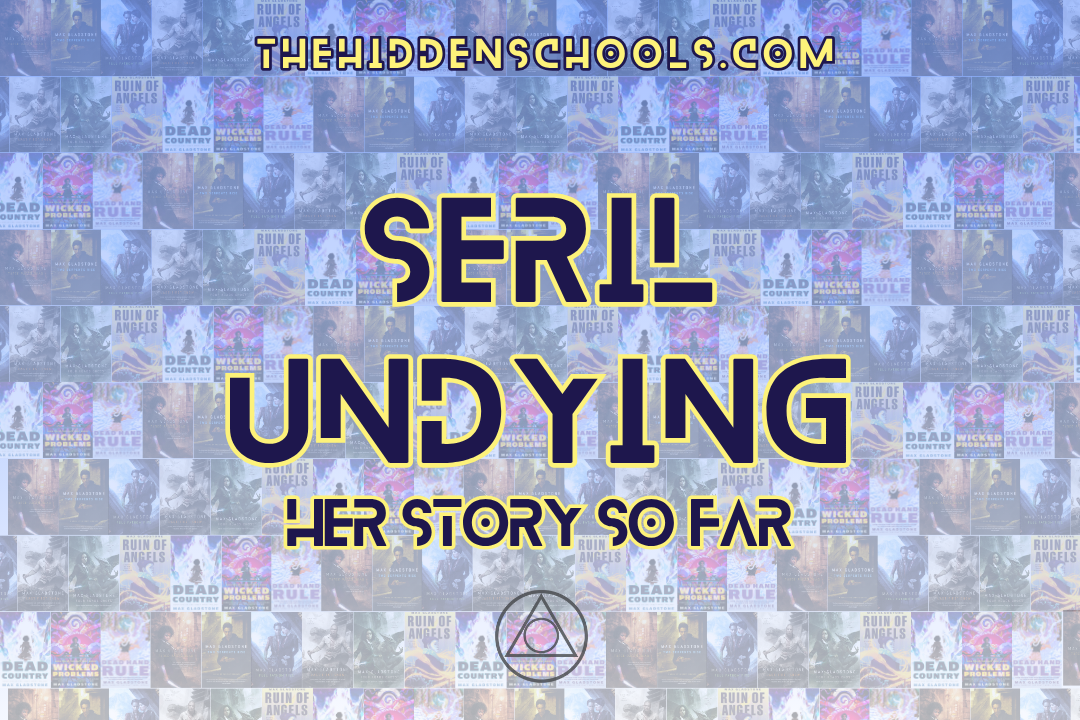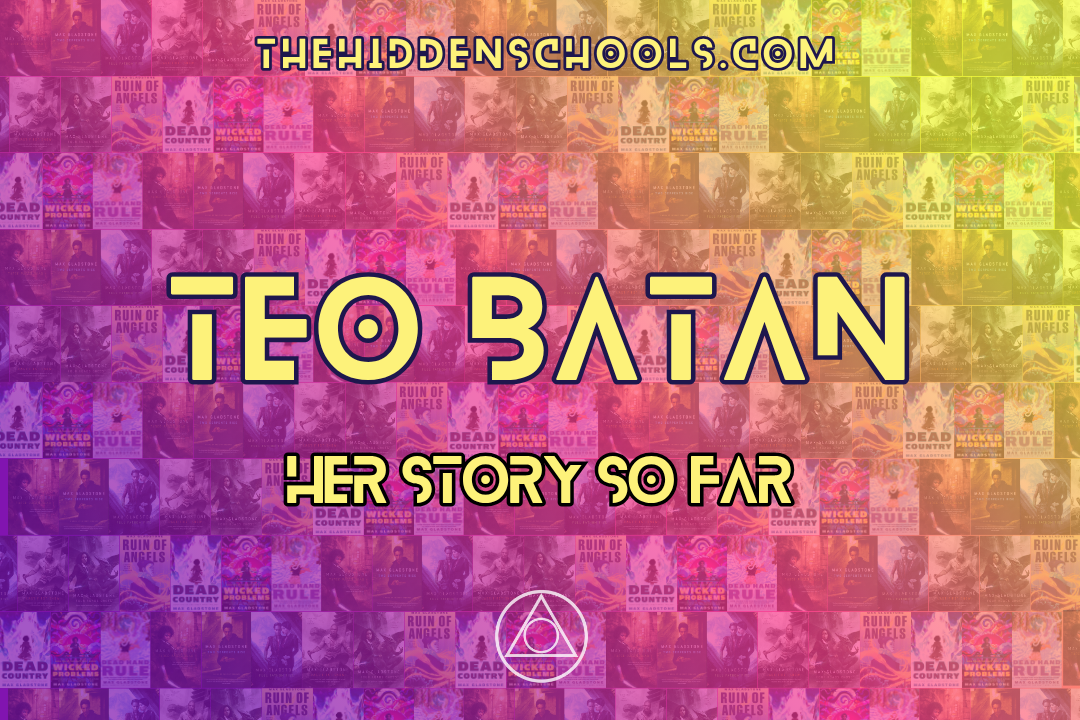5 reasons to read Craft Sequence (+1 reason not to)
The Craft Sequence is one of the best fantasy series of this century. I will be accepting no feedback on this statement.
BUT, what exactly makes it so good? Why should you read the Craft Sequence?
There are countless reasons - I came up with over 20 in a quick brainstorm, but narrowed down to my top 5 for this article. Read on for the top 5 reasons to read the Craft Sequence - plus 1 reason not to.
One. The Characters
When I think of the Craft Sequence, I think of incredible characters. Tara Abernathy and Elayne Kevarian, Kai Pohala and Izza, Temoc Almotil and the King in Red. Gladstone’s characters feel real and lived in. Even characters that have little page-time or POV sections - Gal in Ruin of Angels, Teo in Two Serpents Rise and Full Fathom Five, Mina in Last First Snow - feel fully rounded, not just there to prop up our protagonists.
Everyone feels different enough that you can tell whose POV you are in without being told - a difficult feat. They make active choices, make mistakes, have motivations and prejudices and blind spots. Even the most supremely competent and powerful characters struggle against real stakes and are put into situations where there is no good outcome. No one skates through unharmed, even with a degree of plot armour.
And the characters are diverse without being tokenistic. Current SFF is far more diverse in general than casual readers may realise, so this is hardly unique, but it’s a major plus in my book. I can only think of three white straight men, and two of them are killed off. The majority of characters are of colour, female, many queer – meaning that they don’t have to hold the weight of being the sole representative of their demographic, and can be people rather than stereotypes.
Gladstone writes women so well that upon first read I admit I checked several times whether Max was actually a woman. Speaking to trans readers, I’m told that the same is true for Kai and other trans characters – they are incredibly authentic-feeling representations, something that is rare from a cis writer.
In fact, Gladstone has spoken and written about why he chose to write diverse characters, and how he went about it while being aware of his own major privilege. I highly recommend reading the full article linked above, but a key point for me comes in the last paragraph:
None of the folks in my books “just happen” to be the people they are—I research, I listen to people, I beta my manuscripts widely, I develop compassion and negative capability, I ask, I listen. I work hard to get right the experiences that are beyond mine. I hold my books up to the light when they’re done, and try to ask, honestly: what am I doing here? When I build a character who differs from me in some significant facet, I try to respect those differences; if I don’t, I’m just being a bad writer.
Personally, I am a character-first reader. I can handwave flimsy plots if the characters feel real and resonant (not that you have to do that here). While the Craft Sequence has countless strengths, it is the characters that keep me coming back.
Two. Episodic with overarching plot
An unfinished six book series can be intimidating to new readers, but a beauty of the Craft Sequence is that while the books are interconnected, many are ultimately standalone episodic books. You can therefore start in a variety of places with the books that most appeal to you; you can read duologies if that takes your fancy, or just dip in or out. It’s Discworld on a (much) smaller scale.
Yet, for those who get sucked in or have a completionist mindset, there is an overarching plot and theme that connects all six novels, and which begins ramping up in Full Fathom Five and Ruin of Angels. Not to mention it’s fun to spot character cameos in books that aren’t ‘theirs’.
This also helps the series hold up on re-read – and I’ve done many, many re-reads. You can mix up reading order, appreciate arcs and plots, and see the overarching theme take shape.
Three. Magic systems
The Craft Sequence is set in a fantasy world with two main magic systems that run on a similar logic (more on that in a future article). The magic of the gods is called Applied Theology, and the magic of people is the Craft.
Magic is truly fundamental to every element of the world. It is the basis of law and the economy; it replaces electricity and other public utilities; even currency uses literal pieces of your soul. Gladstone takes the existence of magic to its logical endpoint showing how it fully runs the world.
I also love the basic rule that belief forms reality. Gods have power because people believe in them; the Craft works by imposing your will and belief onto the world and thus shaping it. This may not be unique in the realms of SFF, but I’ve never seen it done quite like in the Craft Sequence. There is something quite beautiful about reading how stories shape reality.
Gods are stories people tell. The Hidden Schools claim gods evolved with us. We order the world in our minds, and our stories gather strength and power. Through them we become more than meat, and through us they become more than wind. Faiths are eyes through which we know the world. Gods and goddesses sing ourselves back to us through time.” ~Ruin of Angels
Four. Writing style
Gladstone’s writing style is immensely readable, putting across complex ideas in understandable terms, deftly sketching out people and places without needing too much info-dumping, and managing tone exceptionally well. Beautiful prose feels completely natural next to a humorous line or satiricial description, and jokes are placed to lighten the atmosphere without feeling early-2000s-TV-show quippy.
Three Parts Dead has descriptions such as:
Tara rode the surf of a silver ocean in moonlight. Or perhaps she was the surf, floating atop the water and one with it at once. When she lay with a lover and woke slowly the next morning, not knowing of or caring for the world beyond her skin, or time beyond her joyous heart’s slow beat, she felt like this, but now her skin was the endless ocean, and her heart beat in measured rhythm against unknown sands.
Alongside conversations like:
“Denovo looks even less aged than you.”
“He drinks the life of those who come too close to him. Steals their youth. Also,” she said after a pause, “he moisturises.”
I don’t know why, but “Also, he moisturises” cracks me up every time I read it.
Five. Real world analogues
Fantasy versions of real world places, events and technology are hardly new. Everyone knows, for example, that Game of Thrones was inspired by the War of the Roses, with clear connections between the story and real history. Any reader of fantasy knows the faux-Europes, the faux-Chinas, the faux-Africas.
The Craft Sequence takes this a deliberate, fascinating step further. Locations are analogous to places in our real world - but with more depth than in many fantasy series - and history, in a way, mirrors ours in terms of technological advancement. Most unusually, however, is that this analogy is a key part of the entire purpose of the books and world rather than a convenient shorthand.
Max Gladstone said in a Reddit AMA that the books “use fantasy to talk about our weird modern world in the same way lots of books use fantasy to approach the medieval world.”
People in debt become literal zombies until they can pay off their loans; start-up culture and gentrification are satirised; police forces are faceless hive minds; the environmental destruction of capitalism is front and centre; gods have credit ratings.
This is both amusing to readers at surface level, and deeply resonant to anyone concerned with these issues in the real world. Capitalism is relentlessly critiqued, but in a way that feels like an adventure novel rather than an economic treatise. If you want your fantasy with depth, but without a soapbox, this is for you.
(+1 Reason not to read)
I am (obviously) a huge fan of this series, and have persuaded countless real life friends to read the books. However, I have been blinded by my own love for the series, and all the praise above, recommending it to some relatives who don’t like fantasy books – and they couldn’t get through the first chapter.
So. If you really don’t like fantasy or magic in the slightest, even when done in an interesting and unusual way, this isn’t for you. Sorry. But you should buy it for any friends who do like fantasy - and point them to this website.
What are your top 5 reasons to read the Craft Sequence? Let me know in the comments or on Twitter.











